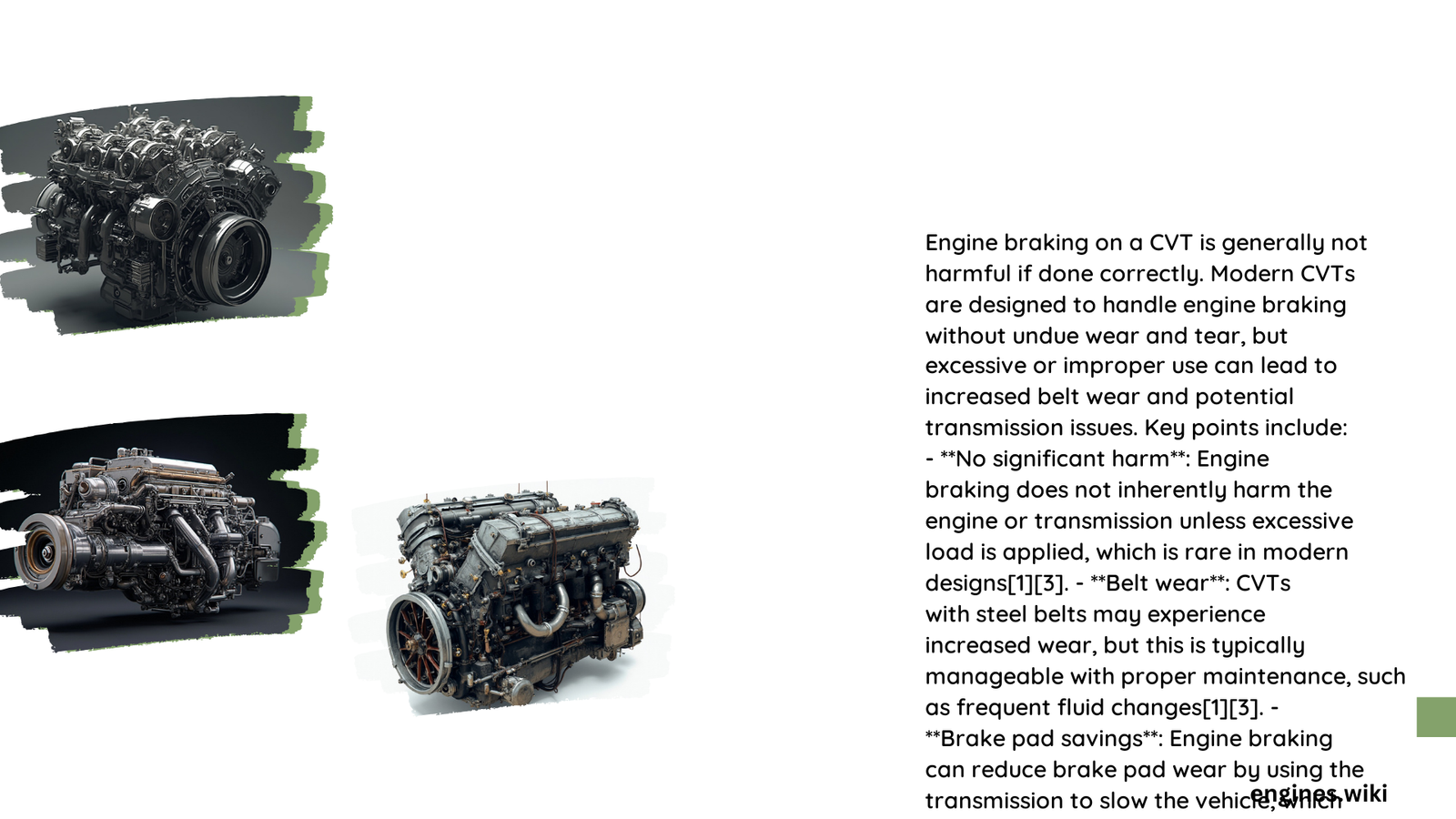Engine braking with a Continuously Variable Transmission (CVT) presents complex mechanical interactions that can potentially compromise transmission longevity. While beneficial in certain driving scenarios, repeated aggressive engine braking might accelerate wear on critical transmission components like belts and chains. Vehicle owners must understand nuanced techniques to minimize potential damage and maintain optimal CVT performance.
What Happens When You Engine Brake with CVT?
Engine braking represents a deceleration technique where drivers remove their foot from the accelerator, allowing the engine’s compression to slow the vehicle. For CVT transmissions, this process introduces unique mechanical stress points that require careful management.
How Does CVT Respond to Engine Braking?
| Transmission Component | Potential Stress Level | Risk Factor |
|---|---|---|
| Belt/Chain System | High | Moderate to Significant |
| Transmission Fluid | Medium | Low to Moderate |
| Pulley Mechanism | Low | Minimal |
Key Mechanical Interactions
- Belt Tension Dynamics
- CVT belts experience variable tension during engine braking
- Sudden RPM changes can create additional mechanical strain
-
Prolonged stress might accelerate component degradation
-
Fluid Circulation Challenges
- Engine braking generates increased internal temperatures
- Transmission fluid experiences higher thermal stress
- Potential acceleration of fluid breakdown
Can Frequent Engine Braking Damage CVT?

Repeated aggressive engine braking can indeed contribute to premature CVT wear. The primary concerns include:
- Increased mechanical stress on belt/chain systems
- Potential accelerated fluid degradation
- Higher risk of unexpected transmission failure
Recommended Engine Braking Practices
- Avoid sudden, dramatic RPM fluctuations
- Maintain moderate deceleration rates
- Use gentle downshifting techniques
- Monitor transmission fluid condition regularly
What Are Safe Engine Braking Techniques for CVT?
- Gradual Deceleration
- Reduce speed smoothly
- Minimize abrupt RPM changes
-
Allow transmission to adjust naturally
-
Temperature Management
- Avoid prolonged high-stress engine braking
- Allow brief cooling periods during extended descents
- Monitor transmission temperature indicators
When Should You Avoid Engine Braking?
- During extreme temperature conditions
- When transmission fluid appears degraded
- On steep, continuous downhill routes
- If vehicle exhibits unusual transmission behavior
Expert Maintenance Recommendations
Vehicle owners should:
– Schedule regular transmission fluid inspections
– Follow manufacturer-recommended maintenance intervals
– Use manufacturer-approved transmission fluids
– Consider professional transmission health assessments annually
Technical Insights
Modern CVT designs have improved durability, but mechanical limitations persist. Manufacturers like Honda, Toyota, and Subaru continue refining transmission technologies to mitigate potential engine braking risks.
Potential Long-Term Consequences
Improper engine braking might lead to:
– Accelerated belt/chain wear
– Reduced transmission efficiency
– Increased repair/replacement costs
– Potential vehicle performance degradation
Cost Considerations
Average CVT replacement costs range between $2,000-$4,000, emphasizing the importance of careful transmission management.
Final Technical Assessment
While engine braking isn’t inherently destructive, systematic, informed approach minimizes potential CVT transmission risks. Understanding your specific vehicle’s design and maintaining disciplined driving techniques remains paramount.
Professional Recommendation
Consult your vehicle’s manufacturer guidelines and consider professional transmission assessments to ensure optimal long-term performance.
References:
1. Unofficial Honda FIT Forums Discussion
2. Subaru Transmission Technical Resources
3. Automotive Technical Institute Blog
